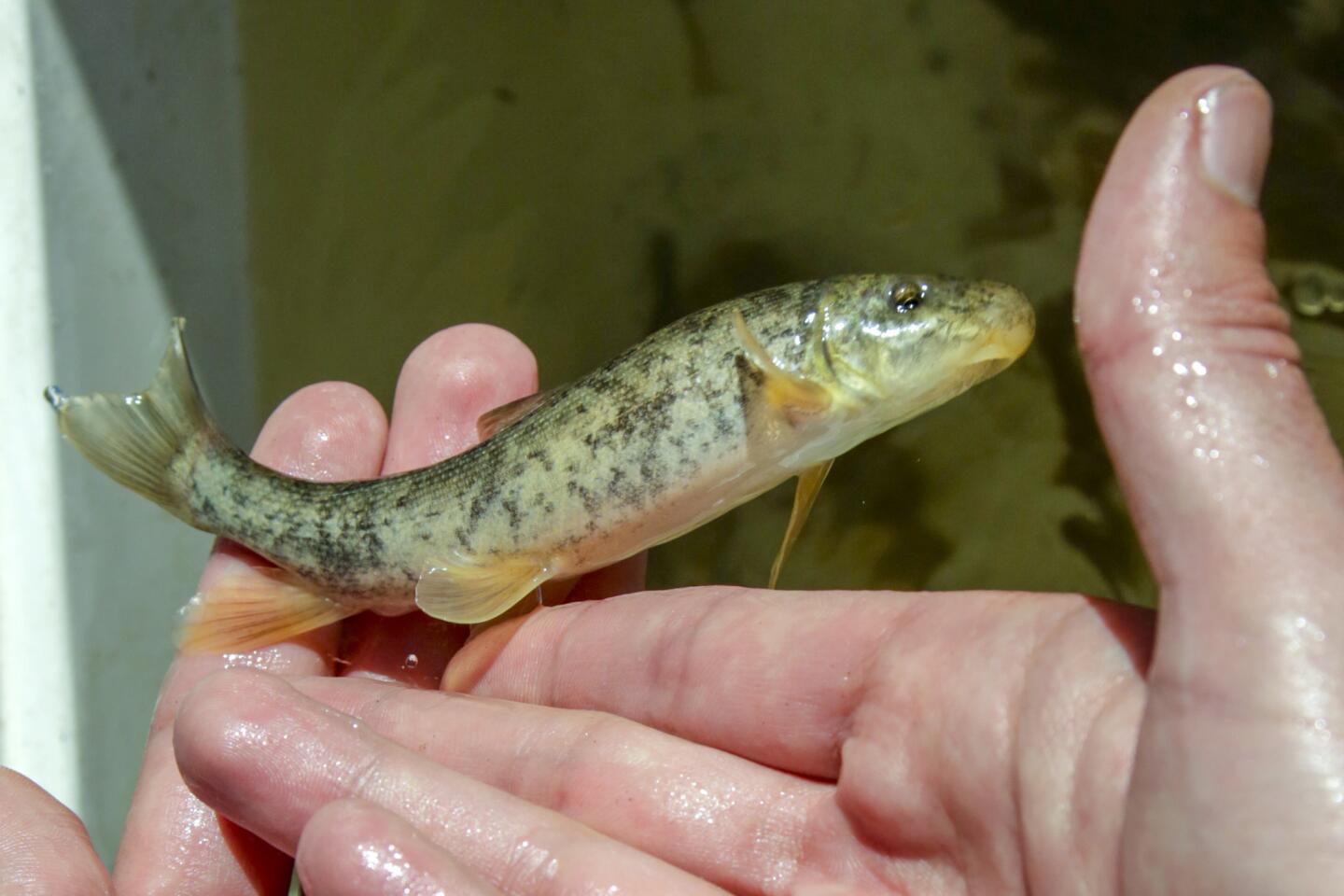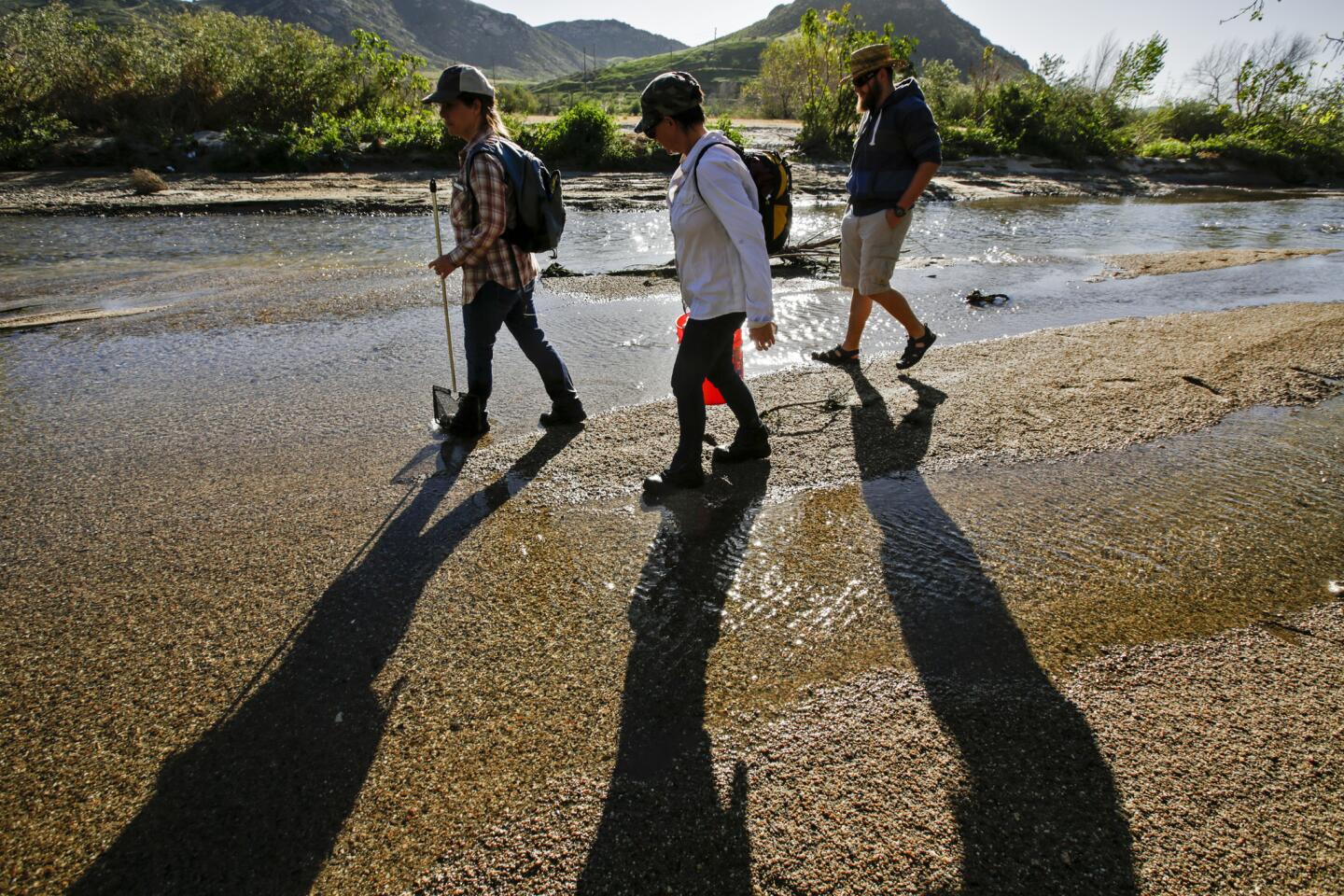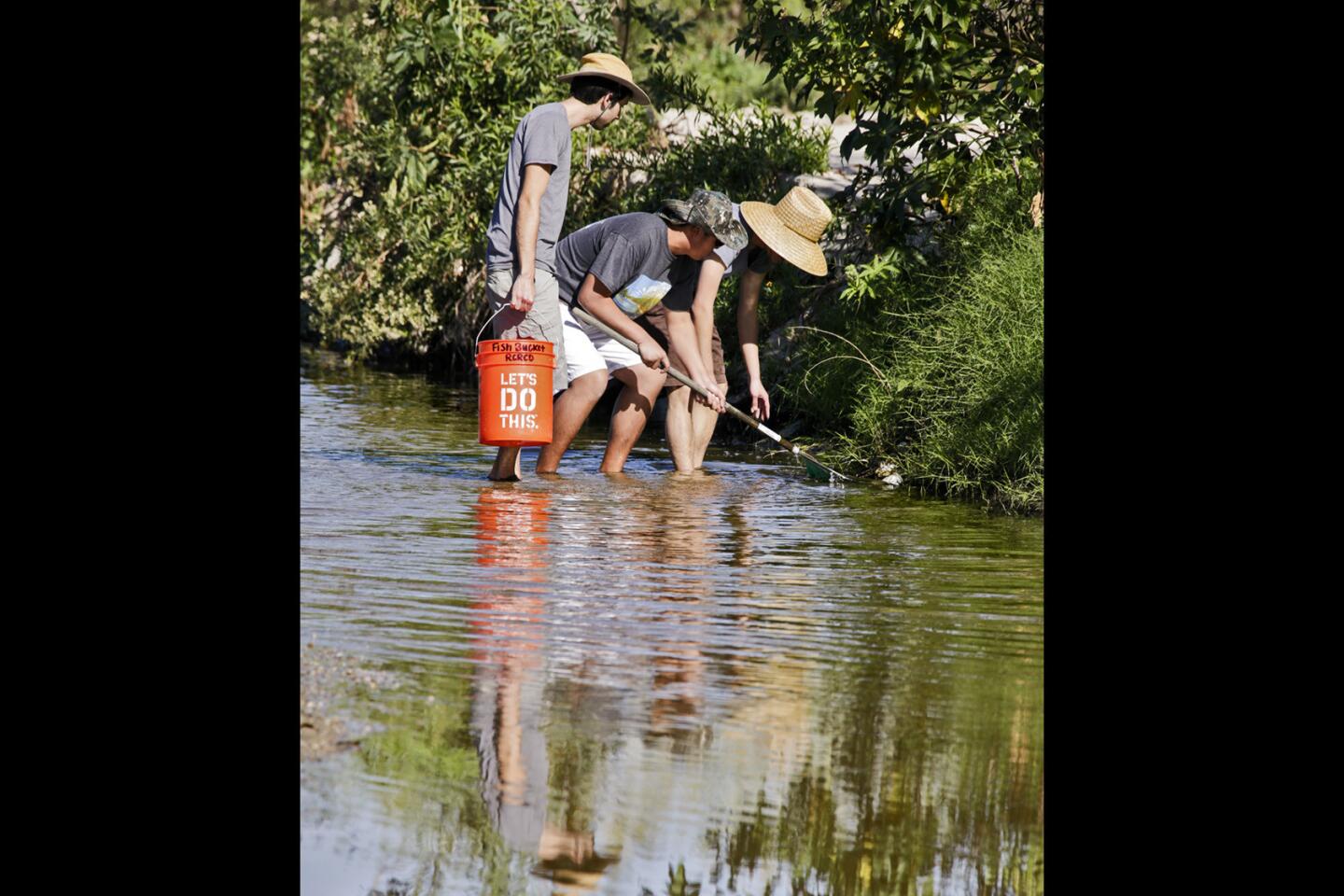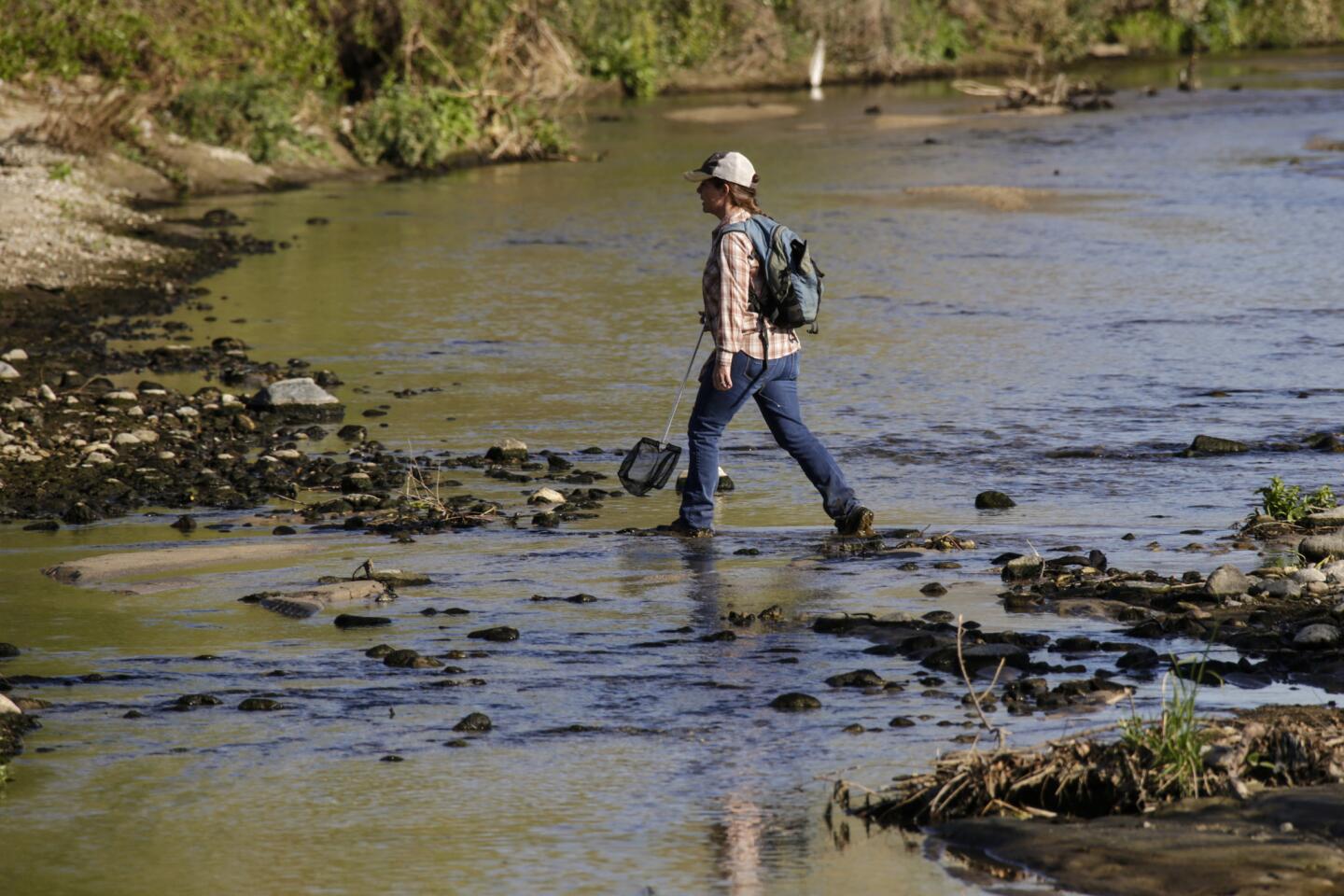Clean water versus the sucker fish: Drought creates a bizarre dilemma
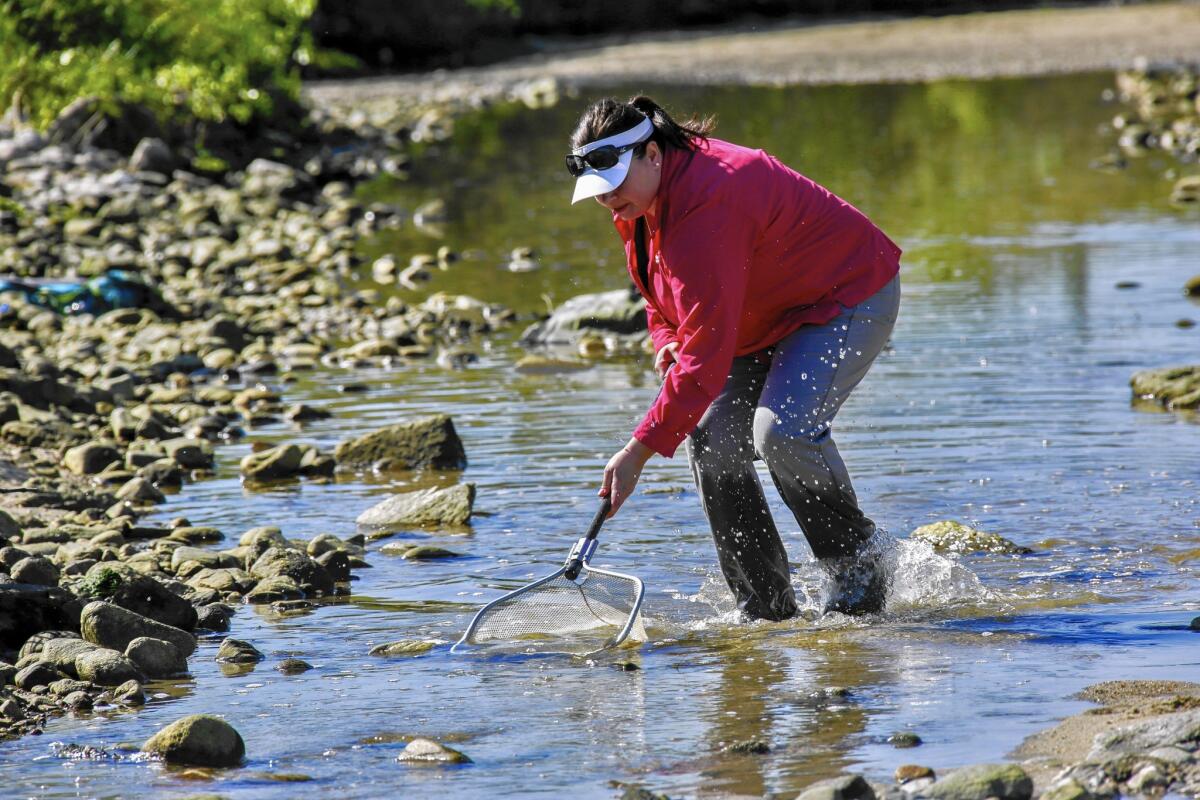
- Share via
The California drought has created many oddities over the last few years but none as bizarre as a scene that unfolds regularly on a tributary of the Santa Ana River.
The stream’s modest flow, provided almost entirely by a San Bernardino water treatment plant, suddenly stops, quickly stranding thousands of threatened Santa Ana sucker fish.
Volunteers and U.S. Fish and Wildlife Service employees dash into the vanishing puddles to net as many of the 4- to 6-inch fish as they can, placing them in buckets of water.
After a few hours, water starts flowing again and workers return the fish to the stream.
See more of our top stories on Facebook >>
Unfortunately, not all of them survive the interruption. Some die before they can be rescued, an enormous loss to a species whose numbers continue to shrink.
The scene unfolds at least once a month in the area between Corona and Riverside, where the water table has fallen so low that, instead of pooling on the surface, standing water in the stream bed soaks rapidly into the ground.
The treatment plant turns off the tap to conduct maintenance required by its operating permits, forcing the U.S. Fish and Wildlife Service and San Bernardino city officials to do a delicate dance around endangered species restrictions.
Under those federal restrictions, the city isn’t allowed to turn off the water because doing so threatens the fish. At the same time, however, federal water law requires the city to perform the regular maintenance because it is the only way to keep the plant’s discharge clean.
“We are caught between the federal Endangered Species Act and the Clean Water Act,” said Stacey Aldstadt, general manager of the San Bernardino Municipal Water District.
“As a result, we’re forced to decide which enforcement agency we can afford to offend worse, Fish and Wildlife or the Regional Water Quality Control Board, which could have us indicted, handcuffed and sent to jail,” Aldstadt said. “Any reasonable person can see we are not the bad guys in this situation.”
Fish and Wildlife sees the dilemma.
“This is not an ideal situation,” spokeswoman Jane Hendron said. “It is the product of extended, extreme drought, and we are working toward solutions that will ensure the water treatment plant complies with the Endangered Species Act.”
Critics are not sympathetic.
“This isn’t some minor, technical violation of the Endangered Species Act,” said John Buse, an attorney with the Center for Biological Diversity. “This is massive, intentional and repeated disregard for the law. And it’s a false choice between violating one law or another when a plant upgrade would solve both concerns.”
The plant relies on an antiquated array of 6,000 ultraviolet lamps to kill viruses and bacteria in urban runoff with lethal doses of radiation.

The Santa Ana sucker and Arroyo chub fish are protected species that get stranded when water runs low in the Santa Ana River.
“When some of those lamps go out and there is insufficient radiation, we are required to shut down the facility and fix them,” Aldstadt said. Maintenance could be reduced by an equipment upgrade, but Aldstadt said the cost would be borne by water users who often must choose between paying for water or putting food on the table.
The dying fish were discovered June 25, 2014, when a team of U.S. Geological Survey researchers reported seeing a large number of dead suckers floating downstream in the Santa Ana River. Federal authorities later determined that the water treatment plant had halted its outflows earlier that day.
The plant’s average outflows of 28 million gallons of treated water per day have been halted at least 60 times over the last two years, according to Regional Water Quality Control Board records.
The total number of Santa Ana suckers killed remains unknown. But records show that 1,361 suckers were rescued in September and January, and at least 81 died before they could be saved.
“The fish are being dealt a serious injustice,” said Jason May, a USGS biologist. “It’s a travesty when you get down to it.”
On Thursday morning, shortly after the treatment plant shut off the flow, the vibrant stream 30 feet wide and 8 to 12 inches deep became a parched course of mostly sand and gravel. Waterfowl and ravens gorged themselves on dead fish.
Forty volunteers focused on rescuing suckers that had sought refuge in rivulets and puddles. Survivors were placed in aerated buckets and ice chests filled with water.
The scene was typical of those that have played out on the stream many times during the drought, with one giant exception. Law enforcement authorities took possession of the dead suckers, numbering at least 15, and 10 dead arroyo chubs, a California fish species of special concern.
“This case is now under investigation,” said Erin Dean, USFWS resident agent in charge of the Southern California region. She declined to elaborate, but people involved in the rescue believe inquiries by The Times led to complaints that resulted in the investigation.
The suckers were once abundant across Southern California. They have mottled gray backs and silver bellies, grow to about 5 inches and have large, thick lips and small mouths to vacuum up algae and other organisms.
Today, they are found in the headwaters of the San Gabriel River in the Angeles National Forest, Big Tujunga Creek in the Los Angeles River Basin, portions of the Santa Ana River and parts of the Santa Clara River system in Los Angeles and Ventura counties.
Since being listed as a threatened species in 2000, its numbers have continued to decline.
The controversy swirling around the treatment plant worries water agencies working with Fish and Wildlife to develop habitat conservation plans on the Santa Ana River that could affect more than 1 million Southern California residents.
“Our chances of getting federal permits to build projects on the river hinge on the health of this sucker population,” said Heather Dyer, a biologist with the San Bernardino Valley Municipal Water District.
Twitter: @LouisSahagun
ALSO
Former Mexican president on Trump: ‘I’m not going to pay for that f------ wall’
While it defies U.S. government, Apple abides by China’s orders — and reaps big rewards
South Carolina black voters say they know Hillary Clinton well enough to pass on Bernie Sanders

